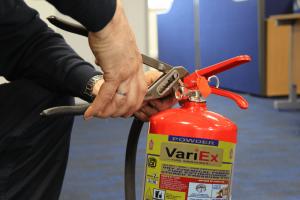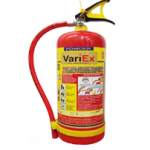![]()
Fire Immuniser
+91-7829629111
Email: info@variex.in
Varistor Technologies Pvt. Ltd.
Block-1, First Floor, Ardente Office One, Hoodi Circle, ITPL Main Road, Bengaluru, Karnataka 560048, IN
How to DIY Refilling an ABC Type Fire Extinguisher
The Refilling an ABC fire extinguisher stands as a versatile defender against various types of fires. While these trusty devices are always at the ready, understanding how to refill them is crucial for maintaining their effectiveness. In this comprehensive guide, Refilling an ABC Fire Extinguishers we'll navigate through the essential steps of refilling an ABC fire extinguisher, empowering you with the knowledge to keep your safety equipment in optimal condition. how to refill an ABC fire extinguisher. Picture it as a superhero getting a recharge, ensuring it's always ready to swoop in and save the day. In this guide, we'll break down the process into simple steps, demystify the terminology, and empower you to take charge of your fire safety. So, whether you're a seasoned safety pro or a novice explorer in the world of fire preparedness, join me on this journey of "How to Refill an ABC Fire Extinguisher.
Understanding ABC Fire Extinguishers
Fire safety is a complex yet crucial aspect of protecting lives and property. In this context, ABC fire extinguishers emerge as versatile and indispensable tools designed to combat various types of fires. Refilling an ABC Fire Extinguishers Before we dive into the intricacies of the refill process, it's imperative to lay down a robust foundation by comprehending the fundamentals of ABC fire extinguishers.
Significance of the ABC Classification: Deciphering the Code ABC isn't just a random assortment of letters; it's a code that holds the key to understanding the extinguisher's capabilities. This classification signifies the extinguisher's ability to combat fires of different classes:
- Class A: Fires involving ordinary combustibles such as wood or paper.
- Class B: Fires fueled by flammable liquids like gasoline or oil.
- Class C: Fires originating from electrical equipment.
This classification ensures that ABC fire extinguishers are versatile, making them suitable for a broad range of fire types.
The Refilling Process - Step by Step
 Assessing the Need: Before initiating the refill process, inspect the ABC fire extinguisher for any visible signs of damage or previous use. Ensure that the pressure gauge indicates a need for refilling.
Assessing the Need: Before initiating the refill process, inspect the ABC fire extinguisher for any visible signs of damage or previous use. Ensure that the pressure gauge indicates a need for refilling.
Gathering Equipment and Materials: Collect the necessary tools and materials for the refill process. This may include a pressure gauge, appropriate extinguishing agent, a funnel, and safety gear such as gloves and goggles.
Venting and Discharge: Safely release any remaining pressure from the extinguisher by venting it in an open, well-ventilated area. Discharge the remaining content to ensure a clean and safe refill process.
Adding Extinguishing Agent: With the extinguisher depressurized, use a funnel to add the correct quantity of the appropriate extinguishing agent. Ensure that you follow the manufacturer's guidelines for the specific type of extinguisher.
Sealing and Testing: Once the extinguishing agent is added, seal the extinguisher securely. Perform a functionality test to ensure that the refill was successful. This may involve a brief discharge to check the spray pattern and pressure.
Inspecting for Leaks: Conduct a thorough inspection for any potential leaks in the extinguisher. Check the seals, valves, and connections to ensure that the extinguisher is airtight and ready for use.
Pressure Adjustment (if needed): If the pressure gauge indicates a need for adjustment, use the appropriate tools to adjust the pressure to the recommended levels. This step ensures that the extinguisher is pressurized correctly.
Replacing Safety Pin and Tamper Seal: Once the refill is complete, replace the safety pin and tamper seal to ensure that the extinguisher remains secure and ready for use. This step is crucial for preventing accidental discharge.
Record Keeping: Maintain a detailed record of the refill, including the date, type, and quantity of extinguishing agent used. Proper record-keeping helps track the maintenance history of the extinguisher.
Compliance with Regulations: Ensure that the refill process complies with local safety regulations and standards. This may include certifications, inspections, and documentation to validate the proper maintenance of the fire extinguisher.
Safety Precautions for Refilling ABC Fire Extinguishers
Protective Gear: Before initiating any steps in the refilling process, ensure that individuals involved are equipped with the appropriate protective gear. This may include safety goggles to shield the eyes from potential splashes, gloves to protect hands from chemicals, and, if necessary, a respirator to guard against inhalation of fumes.
Adequate Ventilation: Perform the refilling process in a well-ventilated area. Adequate ventilation helps disperse any fumes or gases that may be released during the process, reducing the risk of inhalation and promoting a safer working environment. 
Training and Knowledge: Only individuals with proper training and knowledge should undertake the refilling process. Understanding the specific requirements of the extinguisher, the type of extinguishing agent, and the steps involved is crucial to ensure a safe and effective refill.
Emergency Response Planning: Have a well-defined emergency response plan in place. This includes knowing the location of emergency exits, having access to emergency equipment such as eyewash stations and fire blankets, and ensuring everyone involved is aware of the procedures to follow in case of an unexpected incident.
Handling Chemicals Safely: Exercise extreme caution when handling the extinguishing agent. Follow the manufacturer's guidelines for safe handling and storage. Be aware of the potential hazards associated with the chemicals involved in the refill process.
Fire Safety Equipment: Keep fire safety equipment, such as a fire extinguisher or a fire hose, readily accessible during the refill process. This serves as a precautionary measure in case of any accidental ignition or fire-related incidents.
Controlled Environment: Ensure that the refilling process takes place in a controlled environment. Minimize potential sources of ignition, and prohibit smoking or open flames in the vicinity to reduce the risk of fire hazards.
Regular Safety Checks: Conduct regular safety checks on equipment used in the refill process, such as pressure gauges and seals. Any damaged or malfunctioning equipment should be addressed immediately to prevent potential safety risks.
Adherence to Guidelines: Strictly adhere to established guidelines and protocols for the refilling process. Compliance with industry standards and safety regulations is paramount to ensure a systematic and secure approach.
Signs of Need for Refilling
Pressure Gauge Reading: Check the pressure gauge regularly. If the needle is not in the designated green zone or if it falls below the recommended pressure level, it's a clear indication that the extinguisher needs to be refilled.
Visual Inspection: Conduct a visual inspection of the fire extinguisher. Look for any visible damage, corrosion, or leakage. If you notice dents, rust, or any signs of wear and tear, it's essential to have the extinguisher refilled or replaced.
Weighing the Extinguisher: Fire extinguishers have a specified weight, which includes the weight of the extinguishing agent and the canister. Periodically weigh your extinguisher to ensure it meets the manufacturer's specifications. A noticeable decrease in weight could signify a loss of extinguishing agent and the need for a refill.
Last Inspection Date: Keep track of the last inspection date. Most fire extinguishers come with a label indicating when they were last inspected. If it has been more than a year since the last inspection, it's time to schedule a professional check-up and, if necessary, a refill.
Expiry Date of Extinguishing Agent: Check the expiry date of the extinguishing agent, which is often printed on the label. Over time, the chemicals in the extinguisher may lose their effectiveness, rendering the device less capable of suppressing a fire. If the extinguishing agent has expired, it's a clear sign that a refill is needed.
Use or Partial Discharge: If you have used the fire extinguisher, even partially, it needs to be refilled. Even a small discharge can significantly reduce the amount of extinguishing agent available for future use.
Change in Environment or Conditions: Consider any changes in the environment where the fire extinguisher is stored. Exposure to extreme temperatures, humidity, or other adverse conditions can impact the device's integrity and effectiveness. If the extinguisher has been subjected to such conditions, it may require a refill.
DIY Refilling Tips
Assess the Condition: Before attempting any refilling, inspect the fire extinguisher for visible damage, corrosion, or leaks. If you notice any issues, it's crucial to address them before proceeding.
Check the Pressure Gauge: Examine the pressure gauge to ensure it is within the recommended range. If the needle is not in the green zone or has fallen below the specified pressure level, refilling is necessary.
Weigh the Extinguisher: Weigh the fire extinguisher to ensure it meets the manufacturer's specifications. A decrease in weight could indicate a loss of extinguishing agent, warranting a refill.
Verify the Extinguishing Agent's Expiry Date: Check the expiry date of the extinguishing agent, typically found on the label. If the agent has expired, DIY refilling may not be sufficient, and it's advisable to seek professional assistance.
Review Manufacturer Guidelines: Refer to the manufacturer's guidelines and instructions for your specific ABC fire extinguisher model. Different models may have unique requirements for refilling and maintenance.
Use Appropriate Refilling Kits: If you decide to proceed with DIY refilling, ensure you use an appropriate refilling kit designed for ABC fire extinguishers. These kits typically include the necessary tools and materials for a safe and effective refill.
Follow Safety Precautions: Safety should be a top priority. Wear protective gear, including gloves and safety glasses, during the refilling process. Work in a well-ventilated area, away from open flames or sparks.
Avoid Overfilling: Carefully follow the recommended refill quantities to avoid overfilling the extinguisher. Overfilling can lead to increased pressure, compromising the integrity of the device.
Seal and Test: After refilling, securely seal the extinguisher and conduct a pressure test to ensure it is holding the pressure within the acceptable range.
Record Maintenance: Keep a record of the DIY refilling, including the date and details of the process. This record can be useful for future reference and professional inspections.
In conclusion, understanding how to refill an ABC fire extinguisher is a valuable skill that contributes to the overall effectiveness of this crucial safety device. While some basic maintenance and inspection can be performed by individuals following DIY tips, it is important to recognize the limits of such efforts. Professional services remain the recommended choice for comprehensive inspections, testing, and refilling to ensure the extinguisher's reliability in critical situations. DIY enthusiasts should adhere closely to manufacturer guidelines, use appropriate refilling kits, and prioritize safety precautions during the process. However, it is crucial to acknowledge that certain aspects, such as verifying the expiry date of the extinguishing agent and addressing any damage or leaks, may require professional expertise.
Frequently Asked Questions
Can I refill my ABC fire extinguisher myself?
While it's technically possible to refill an ABC fire extinguisher using a recharge kit, it is highly recommended to have this task performed by a certified professional. They have the expertise to ensure the correct type and amount of extinguishing agent is used, and they can inspect the extinguisher for any damage or issues.
How often should I refill my ABC fire extinguisher?
Refilling your ABC fire extinguisher is necessary after each use, regardless of the amount discharged. Additionally, regular inspections should be conducted, and if the pressure gauge indicates a recharge is needed or if the extinguisher has passed its expiration date, immediate refilling is crucial.
What is the correct recharge agent for an ABC fire extinguisher?
ABC fire extinguishers typically use a dry chemical agent composed of monoammonium phosphate. When refilling, ensure that the recharge agent matches the type specified by the extinguisher's manufacturer. Using the wrong agent can compromise the extinguisher's effectiveness.
Can I reuse the discharged agent when refilling my ABC fire extinguisher?
It is not recommended to reuse the discharged agent. Once the fire extinguisher has been activated, the expelled agent may have lost its effectiveness or absorbed moisture, rendering it less efficient. It's best to use a new, fresh recharge agent.
How do I know if my ABC fire extinguisher needs to be refilled?
Regular visual inspections are crucial. Check for any physical damage, loss of pressure indicated on the gauge, or if the extinguisher has been used, it must be refilled. Additionally, always refer to the manufacturer's guidelines and schedule regular professional inspections.
Final Say
We at VariEx.in or Variexonline.com have mastered the art of designing, installing, inspecting, and fixing automatic sprinkler systems with the help of our in-house team, which is capable of delivering the fire sprinkler services you need, whether large or small and at affordable cost.
To schedule a fire sprinkler installation, or you think our services could benefit your commercial property, contact us online or give us a call at, 7829629111










